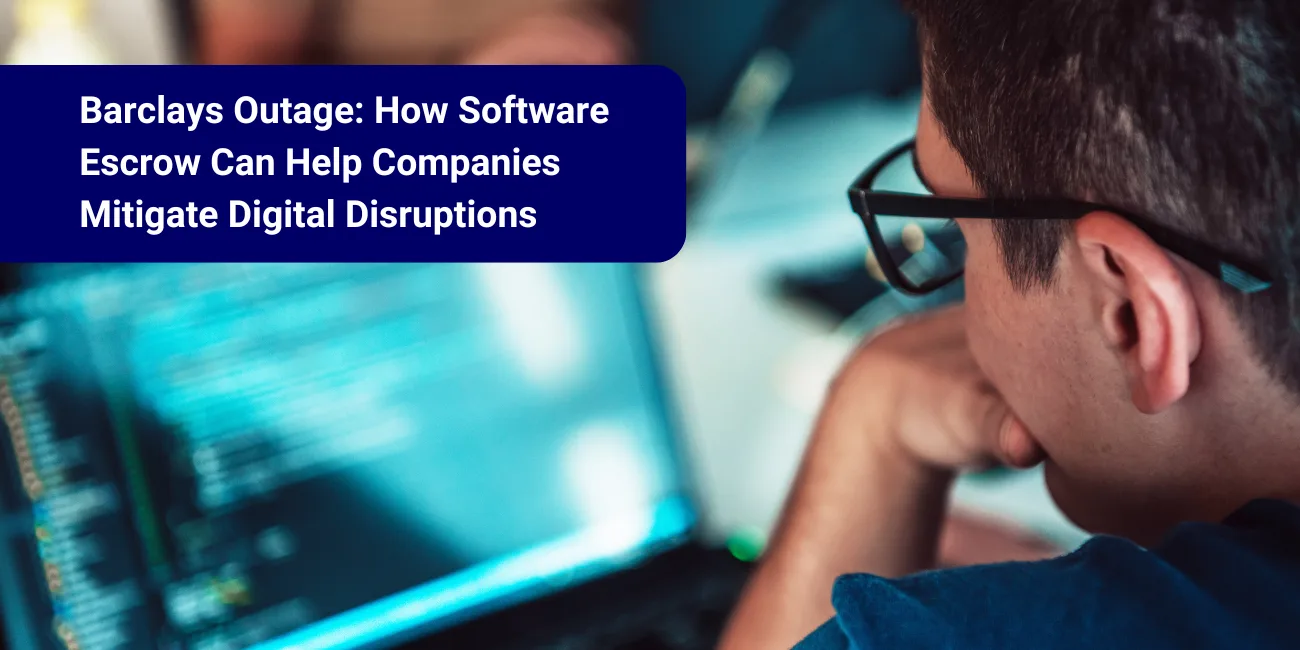Barclays Outage: How Software Escrow Can Help Mitigate Digital Disruptions
Introduction
In early February 2025, Barclays Bank experienced a significant IT outage that disrupted banking services for several days, affecting millions of UK customers. This incident highlights the vulnerabilities of an increasingly digital world and the critical need for operational resilience, particularly in the financial sector.
The Barclays Incident: A Case Study in Digital Disruption
The outage began on Friday, 31 January 2025, coinciding with payday for many British workers and the deadline for self-assessment tax returns. Customers were unable to access online and mobile banking, make payments, or view accurate account balances, leaving many in financial limbo.
Barclays confirmed that the issue was not a cyberattack but a technical failure that took several days to resolve. The bank worked to process delayed payments and extended call centre hours, but damage was already done, both financially and reputationally.
The Ripple Effect of IT Failures
The Barclays outage highlights the wide-reaching impact of IT failures in the financial sector:
- Financial disruption: Customers struggled with essential transactions, from paying bills to grocery shopping.
- Business interruptions: Companies relying on Barclays for merchant services faced difficulties processing payments, leading to lost revenue.
- Regulatory scrutiny: The incident attracted attention from regulators and lawmakers, fuelling calls for stronger oversight of banking IT infrastructure.
- Reputational damage: The prolonged disruption and perceived lack of transparency eroded customer trust.
The Role of Software Escrow in Mitigating Digital Risks
Although the Barclays outage was caused by internal IT issues, it highlights the broader need for robust risk management strategies to cover a range of challenges from security risks to continuity of service. To be able to withstand technical IT incidents, disaster recovery and issue with your supply chain. Its events like these that remind us that planning for and testing different circumstances is essential. One option that falls into a comprehensive operational risk framework is software escrow and verification testing to assist with critical 3rd party supplier failure.
What Is Software Escrow?
Software escrow is a risk mitigation tool involving a three-party agreement between a software vendor, a client (licensee), and a neutral third-party escrow agent. The vendor deposits source code and other critical materials with the escrow agent, who can release them to the client under pre-agreed conditions such as vendor bankruptcy, failure to support the software, or disruptions that impact service continuity. There are also SaaS escrow options related to accessing production systems or additional support services from the escrow agent.
How Software Escrow Enhances Digital Resilience
- Business continuity: Provides access to source code and essential materials such as data, allowing businesses to maintain critical applications during vendor failures or service disruptions.
- Reduces concentration risk: Mitigates risks associated with relying solely on a single software provider with the ability to recover
- Supports compliance and legal obligations: Helps regulated industries, such as finance, meet legal requirements for software accessibility and maintainability.
- Protects investment: Safeguards the time and resources spent integrating and customising software solutions.
- Testing certain failure events: When the materials are deposited into escrow, the escrow agent can verify the build and deployment processes to assist with knowledge share and a speedy recovery process.
- Resources – Option for escrow agent to provide ongoing service support
Applying Software Escrow Principles to Internal IT Resilience
While traditionally used for third-party vendor relationships, software escrow principles can also be adapted to strengthen internal IT resilience:
- Internal code repositories: Maintain secure backups of critical software, configuration files, and documentation, reducing reliance on key individuals or developers.
- Regular testing and validation: Periodically test backup systems and disaster recovery plans to ensure functionality.
- Comprehensive documentation: Keep detailed records of system architecture, processes, and recovery protocols.
The Future of Digital Resilience
The Barclays outage is a reminder for organisations to prioritise digital resilience. As financial institutions and businesses become more dependent on technology, adopting risk management tools such as software escrow will be crucial.
Regulators are also taking action. The EU Digital Operational Resilience Act (DORA) emphasises the importance of technology resilience in finance, aligning with software escrow principles. Organisations that integrate these practices will be better positioned to navigate digital disruptions and meet regulatory requirements.
Lessons from Barclays
The Barclays outage serves as a wake-up call, reinforcing the need for:
- Robust IT infrastructure with built-in redundancies
- Comprehensive disaster recovery and business continuity plans
- Clear crisis communication strategies
- Regular testing and system updates
Software escrow, as part of a broader resilience strategy, helps businesses safeguard critical software assets and maintain operations during disruptions. In an era of rapid technological advancement, those who prioritise resilience will be best equipped to navigate future challenges.
To understand more about Software Escrow and how Escrow London can help click here.
To keep up to date with Escrow London follow us on LinkedIn.








